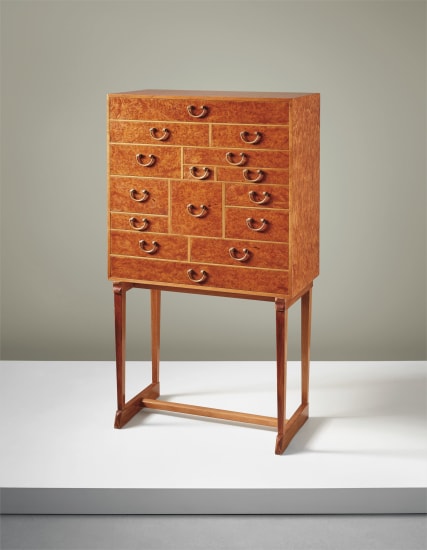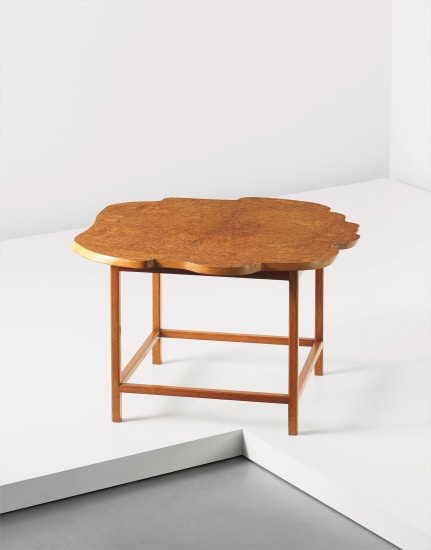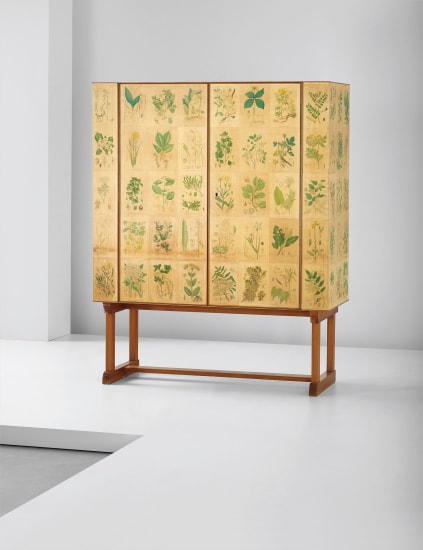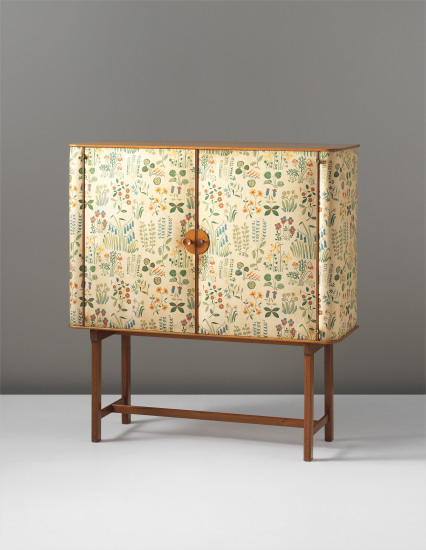38 Josef Frank ‘Flora’ cabinet, model no. 852 designed 1937, executed 1940s Mahogany-veneered wood, mahogany, birch, brass, printed paper. 140 x 116.4 x 43 cm (55 1/8 x 45 7/8 x 16 7/8 in) Manufactured by Svenskt Tenn, Stockholm, Sweden. Exterior covered with paper illustrations from Nordens Flora by C. A. Lindman.
Provenance Jackson Design AB, Stockholm Literature Form, nos. 1-10, 1938, n.p. Josef Frank 1885–1967 – Minnesutställning, exh., cat, National Museum of Stockholm, 1968, p. 33 1885-1985: Josef Frank 100 ar - Jubileumsutställning hösten 1985, exh. cat., Svenskt Tenn, Stockholm, 1985, p. 23 Nina Stritzler-Levine, ed., Josef Frank Architect and Designer: An Alternate Vision of the Modern Home, New Haven, 1996, p. 71, fig. 4-9 Christopher Long Josef Frank Life and Work, Chicago, 2002, p. 235, fig. 218 Christoph Thun-Hohenstein, Herman Czech and Sebastian Hackenschmidt, Josef Frank Against Design, The Architect's Anti-Formalist Oeuvre, exh. cat., Museum für Angewandte Kunst, Vienna, 2015, p. 310 Catalogue Essay In a clear departure from the functionalist aesthetic championed by early modernists such as Le Corbusier, Josef Frank stressed in 1934 that “The home must not be a mere efficient machine”. Vienna-born Frank, who lived and worked in Stockholm from 1933, embraced colours, patterns, and historical influences as a designer for the interior design company Svenskt Tenn, which had been founded by the pewterer Estrid Ericson in 1924. An example is the present ‘Flora’ cabinet, for which Frank gleaned illustrations from the book Bilder ur Nordens Flora by Swedish botanist Carl Axel Magnus Lindman. The simple form, reminiscent of a seventeenth-century cabinet-on-stand, references the past yet remains decidedly modern. Frank and Ericson exhibited the same design for an exhibition of five model rooms at Kaufman’s department store in Pittsburgh in 1951—a fitting, nationalistic choice for introducing Swedish design to America. The partnership between Frank and Ericson lasted for 33 years. Frank was able to work within Svenskt Tenn with absolute freedom. Journalist Eva von Zweigbergk referred to their relationship as ‘a symbiosis’, and wrote that Estrid Ericson "approved of everything that Frank designed, and he, in turn, fulfilled every request she made". Svenskt Tenn’s archives house 2,000 furniture sketches and 160 textile designs by Josef Frank Read More
38 Josef Frank ‘Flora’ cabinet, model no. 852 designed 1937, executed 1940s Mahogany-veneered wood, mahogany, birch, brass, printed paper. 140 x 116.4 x 43 cm (55 1/8 x 45 7/8 x 16 7/8 in) Manufactured by Svenskt Tenn, Stockholm, Sweden. Exterior covered with paper illustrations from Nordens Flora by C. A. Lindman.
Provenance Jackson Design AB, Stockholm Literature Form, nos. 1-10, 1938, n.p. Josef Frank 1885–1967 – Minnesutställning, exh., cat, National Museum of Stockholm, 1968, p. 33 1885-1985: Josef Frank 100 ar - Jubileumsutställning hösten 1985, exh. cat., Svenskt Tenn, Stockholm, 1985, p. 23 Nina Stritzler-Levine, ed., Josef Frank Architect and Designer: An Alternate Vision of the Modern Home, New Haven, 1996, p. 71, fig. 4-9 Christopher Long Josef Frank Life and Work, Chicago, 2002, p. 235, fig. 218 Christoph Thun-Hohenstein, Herman Czech and Sebastian Hackenschmidt, Josef Frank Against Design, The Architect's Anti-Formalist Oeuvre, exh. cat., Museum für Angewandte Kunst, Vienna, 2015, p. 310 Catalogue Essay In a clear departure from the functionalist aesthetic championed by early modernists such as Le Corbusier, Josef Frank stressed in 1934 that “The home must not be a mere efficient machine”. Vienna-born Frank, who lived and worked in Stockholm from 1933, embraced colours, patterns, and historical influences as a designer for the interior design company Svenskt Tenn, which had been founded by the pewterer Estrid Ericson in 1924. An example is the present ‘Flora’ cabinet, for which Frank gleaned illustrations from the book Bilder ur Nordens Flora by Swedish botanist Carl Axel Magnus Lindman. The simple form, reminiscent of a seventeenth-century cabinet-on-stand, references the past yet remains decidedly modern. Frank and Ericson exhibited the same design for an exhibition of five model rooms at Kaufman’s department store in Pittsburgh in 1951—a fitting, nationalistic choice for introducing Swedish design to America. The partnership between Frank and Ericson lasted for 33 years. Frank was able to work within Svenskt Tenn with absolute freedom. Journalist Eva von Zweigbergk referred to their relationship as ‘a symbiosis’, and wrote that Estrid Ericson "approved of everything that Frank designed, and he, in turn, fulfilled every request she made". Svenskt Tenn’s archives house 2,000 furniture sketches and 160 textile designs by Josef Frank Read More















Testen Sie LotSearch und seine Premium-Features 7 Tage - ohne Kosten!
Lassen Sie sich automatisch über neue Objekte in kommenden Auktionen benachrichtigen.
Suchauftrag anlegen